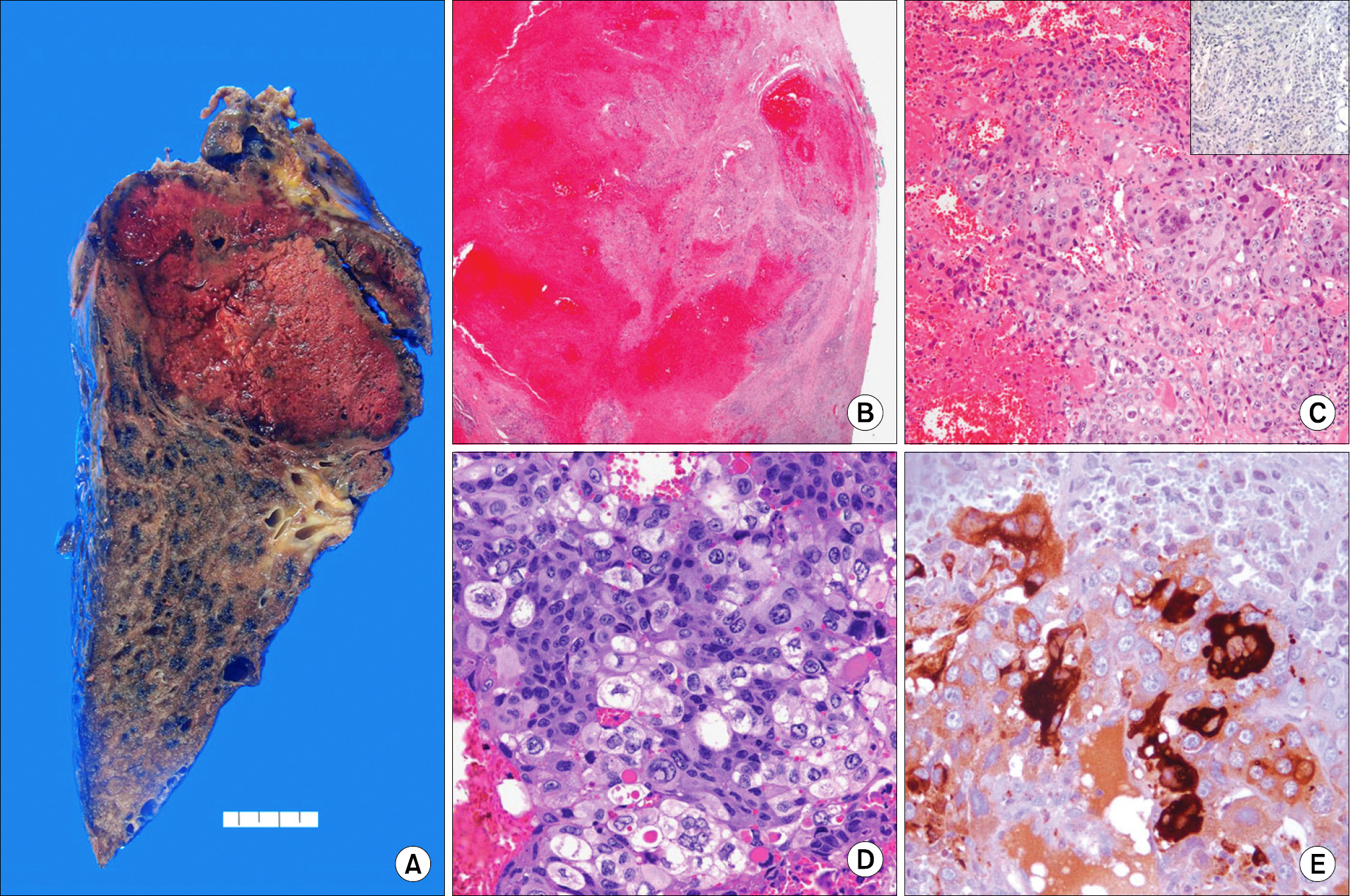J Lung Cancer.
2011 Jun;10(1):44-48. 10.6058/jlc.2011.10.1.44.
Pulmonary Carcinoma with beta-Human Chorionic Gonadotropin Expression: Further Understanding and Suggestions for This Entity from Six Cases Experience in a Single Institution
- Affiliations
-
- 1Department of Pathology, Samsung Medical Center, Sungkyunkwan University School of Medicine, Seoul, Korea. hanjho@skku.edu
- 2Department of Thoracic Surgery, Samsung Medical Center, Sungkyunkwan University School of Medicine, Seoul, Korea.
- KMID: 2199894
- DOI: http://doi.org/10.6058/jlc.2011.10.1.44
Abstract
- PURPOSE
beta-human chorionic gonadotropin (beta-hCG) expressing pulmonary carcinoma is very rare, and little is known about this entity. The aim of this study was to find the characteristic clinicopathologic features of beta-hCG expressing pulmonary carcinoma.
MATERIALS AND METHODS
Of all 2790 lobectomy specimens of lung excised between January 2006 and December 2010, only six cases of beta-hCG expressing pulmonary carcinoma were identified retrospectively. The cases were classified according to the WHO classification, and clinicopathologic features were investigated.
RESULTS
The patients consisted of 4 males and 2 females, and the median age was 64 years. Half of the patients presented with blood tinged sputum or hemoptysis. The median tumor diameter was 4.2 cm. All but one case showed prominent area of hemorrhage and necrosis. All six cases were pleomorphic carcinoma, composed of various types of non-small cell carcinomatous component and giant cell component. All cases showed significant area of beta-hCG positivity, and beta-hCG was usually expressed in the pleomorphic giant cells.
CONCLUSION
In pulmonary carcinoma with pleomorphic giant cells, is necessary to check immunohistochemical stain for beta-hCG and to follow up the serum beta-hCG levels, to further establish the concept of beta-hCG expressing pulmonary carcinoma.
MeSH Terms
Figure
Reference
-
1. Fukayama M, Hayashi Y, Koike M, Hajikano H, Endo S, Okumura H. Human chorionic gonadotropin in lung and lung tumors. Immunohistochemical study on unbalanced distribution of subunits. Lab Invest. 1986; 55:433–443.2. Miyake M, Ito M, Mitsuoka A, et al. Alpha-fetoprotein and human chorionic gonadotropin-producing lung cancer. Cancer. 1987; 59:227–232.
Article3. Szturmowicz M, Slodkowska J, Zych J, et al. Frequency and clinical significance of beta-subunit human chorionic gonadotropin expression in non-small cell lung cancer patients. Tumour Biol. 1999; 20:99–104.
Article4. Yokotani T, Koizumi T, Taniguchi R, et al. Expression of alpha and beta genes of human chorionic gonadotropin in lung cancer. Int J Cancer. 1997; 71:539–544.5. Yoshimoto T, Higashino K, Hada T, et al. A primary lung carcinoma producing alpha-fetoprotein, carcinoembryonic antigen, and human chorionic gonadotropin. Immunohistochemical and biochemical studies. Cancer. 1987; 60:2744–2750.
Article6. Forst T, Beyer J, Cordes U, et al. Gynaecomastia in a patient with a hCG producing giant cell carcinoma of the lung. Case report. Exp Clin Endocrinol Diabetes. 1995; 103:28–32.7. Ha SY, Cho HY, Lee JI. Epitheilioid trophoblastic tumor of the lung: a case report. J Lung Cancer. 2009; 8:114–117.
Article8. Okutur K, Hasbal B, Aydin K, et al. Pleomorphic carcinoma of the lung with high serum beta-human chorionic gonadotropin level and gynecomastia. J Korean Med Sci. 2010; 25:1805–1808.
Article9. Hirano H, Yoshida T, Sakamoto T, et al. Pulmonary pleomorphic carcinoma producing hCG. Pathol Int. 2007; 57:698–702.
Article10. Travis WD, Brambilla E, Muller-Hermelink HK, Harris CC, editors. World Health Organization Classification of Tumours. Pathology and genetics of tumours of the lung, pleura, thymus and heart. IARC Press: Lyon. 2004.11. Krefting IP, Nunez LA, Sherer P, Weinstock A, Kumar A, Travis W. Pleomorphic carcinoma (spindle and giant cell) of the lung. Md Med J. 1994; 43:787–790.12. Fishback NF, Travis WD, Moran CA, Guinee DG Jr, McCarthy WF, Koss MN. Pleomorphic (spindle/giant cell) carcinoma of the lung. A clinicopathologic correlation of 78 cases. Cancer. 1994; 73:2936–2945.
Article13. Ikura Y, Inoue T, Tsukuda H, Yamamoto T, Ueda M, Kobayashi Y. Primary choriocarcinoma and human chorionic gonadotrophin-producing giant cell carcinoma of the lung: are they independent entities? Histopathology. 2000; 36:17–25.
Article
- Full Text Links
- Actions
-
Cited
- CITED
-
- Close
- Share
- Similar articles
-
- Patterns of the decline in serum beta-human chorionic gonadotropin level in patients with tubal pregnancy following surgery by pelviscopy and by laparotomy
- The significance of first trimester maternal serum alpha-fetoprotein and beta-human chorionic gonadotropin measurements before chorionic cillus sampling
- The effect of human immunoglobulin and chorionic gonadotropin on the production of maternal blocking antibody
- Response of Human Chorionic Gonadotropin to 6-D-Trp-Gonadotropin-Releasing Hormone and Gonadotropin-Releasing Hormone Stimulation in the Culture Media of Normal Human Placenta of Different Gestational Ages
- Skeletal Muscle Metastasis and Elevated beta-HCG Level Secondary to Tongue Cancer: a Case Report and Review of Literature


